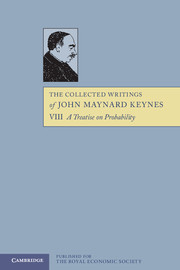Book contents
- Frontmatter
- Contents
- General Introduction
- Editorial Foreword by R. B. Braithwaite
- Editorial Note
- Preface to the First Edition
- I FUNDAMENTAL IDEAS
- II FUNDAMENTAL THEOREMS
- 10 INTRODUCTORY
- 11 THE THEORY OF GROUPS, WITH SPECIAL REFERENCE TO LOGICAL CONSISTENCE, INFERENCE, AND LOGICAL PRIORITY
- 12 THE DEFINITIONS AND AXIOMS OF INFERENCE AND PROBABILITY
- 13 THE FUNDAMENTAL THEOREMS OF NECESSARY INFERENCE
- 14 THE FUNDAMENTAL THEOREMS OF PROBABLE INFERENCE
- 15 NUMERICAL MEASUREMENT AND APPROXIMATION OF PROBABILITIES
- 16 OBSERVATIONS ON THE THEOREMS OF CHAPTER 14 AND THEIR DEVELOPMENTS, INCLUDING TESTIMONY
- 17 SOME PROBLEMS IN INVERSE PROBABILITY, INCLUDING AVERAGES
- III INDUCTION AND ANALOGY
- IV SOME PHILOSOPHICAL APPLICATIONS OF PROBABILITY
- V THE FOUNDATIONS OF STATISTICAL INFERENCE
- Bibliography
- Index
10 - INTRODUCTORY
from II - FUNDAMENTAL THEOREMS
Published online by Cambridge University Press: 05 November 2012
- Frontmatter
- Contents
- General Introduction
- Editorial Foreword by R. B. Braithwaite
- Editorial Note
- Preface to the First Edition
- I FUNDAMENTAL IDEAS
- II FUNDAMENTAL THEOREMS
- 10 INTRODUCTORY
- 11 THE THEORY OF GROUPS, WITH SPECIAL REFERENCE TO LOGICAL CONSISTENCE, INFERENCE, AND LOGICAL PRIORITY
- 12 THE DEFINITIONS AND AXIOMS OF INFERENCE AND PROBABILITY
- 13 THE FUNDAMENTAL THEOREMS OF NECESSARY INFERENCE
- 14 THE FUNDAMENTAL THEOREMS OF PROBABLE INFERENCE
- 15 NUMERICAL MEASUREMENT AND APPROXIMATION OF PROBABILITIES
- 16 OBSERVATIONS ON THE THEOREMS OF CHAPTER 14 AND THEIR DEVELOPMENTS, INCLUDING TESTIMONY
- 17 SOME PROBLEMS IN INVERSE PROBABILITY, INCLUDING AVERAGES
- III INDUCTION AND ANALOGY
- IV SOME PHILOSOPHICAL APPLICATIONS OF PROBABILITY
- V THE FOUNDATIONS OF STATISTICAL INFERENCE
- Bibliography
- Index
Summary
1. In Part I we have been occupied with the epistemology of our subject, that is to say, with what we know about the characteristics and the justification of probable knowledge. In Part II I pass to its formal logic. I am not certain of how much positive value this Part will prove to the reader. My object in it is to show that, starting from the philosophical ideas of Part I, we can deduce by rigorous methods out of simple and precise definitions the usually accepted results, such as the theorems of the addition and multiplication of probabilities and of inverse probability. The reader will readily perceive that this Part would never have been written except under the influence of Mr Russell's Principia Mathematica. But I am sensible that it may suffer from the overelaboration and artificiality of this method without the justification which its grandeur of scale affords to that great work. In common, however, with other examples of formal method, this attempt has had the negative advantage of compelling the author to make his ideas precise and of discovering fallacies and mistakes. It is a part of the spade-work which a conscientious author has to undertake; though the process of doing it may be of greater value to him than the results can be to the reader, who is concerned to know, as a safeguard of the reliability of the rest of the construction, that the thing can be done, rather than to examine the architectural plans in detail.
- Type
- Chapter
- Information
- The Collected Writings of John Maynard Keynes , pp. 125 - 132Publisher: Royal Economic SocietyPrint publication year: 1978



